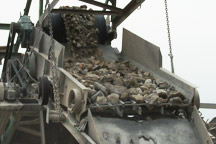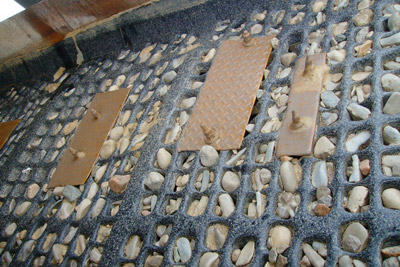Plugging/Pegging
 This is the occurrence of near-sized material trapped in the openings, or apertures, of the screen media’s openings. This “near-sized” material attempts to pass through the openings, but because of its particular shape, this aggregate cannot freely travel over, or freely pass through, the apertures. Therefore, these aggregate particles become “wedged” in the openings and cannot be dislodged, creating the plugging or pegging conditions.
This is the occurrence of near-sized material trapped in the openings, or apertures, of the screen media’s openings. This “near-sized” material attempts to pass through the openings, but because of its particular shape, this aggregate cannot freely travel over, or freely pass through, the apertures. Therefore, these aggregate particles become “wedged” in the openings and cannot be dislodged, creating the plugging or pegging conditions.
Plugging or pegging can severely inhibit efficient aggregate production and, often creates a fine carry-over situation where product contamination exists; e.g., the fines cannot be removed efficiently. (see image below)

What can be done?
Depending on your particular screening application, several low cost/no cost, solutions are possible.
Determine the rotation of your vibrating screen.
Rotation, or direction of throw, is often very critical to successful and efficient aggregate separation. Plugging or pegging conditions are most often observed with primary screening or the “Scalping” applications. Here, the oversized material is simply removed from the undersized material. Oversized material is then re-crushed and re-screened through the same primary circuit and the undersized material is then further processed, screened, and/or re-crushed in the secondary or tertiary operations.
Normally, a vast majority of the primary scalping screens have an excess capacity, removing the oversized material and efficiently passing the undersized. There are, however, many applications where this effective separation of the oversized material, from the undersized material becomes difficult, and most often this is due to the plugging or pegging conditions.
Operating the screen in a forward direction (with flow) is often the most desirable mode of operation. This rapidly transfers the oversized material off the screen deck and allows a greater volume of material to be processed quickly. The fine material, “seeing no apparent obstacles,” passes freely through the larger opening sizes that are normally used here.
Operating the screen in reverse direction (against flow) is sometimes the logical choice. This mode of operation largely depends on the inclination of your particular screening machine. Reverse operation is sometimes the best choice regarding the direction of screen operation. On steeply inclined vibrating screens, where the oversized material rapidly passes over the top deck, reverse throw may be the best option. This “backward” rotation helps retain the oversized material longer and also allows the undersized material which freely travels down the inclined deck, to be more efficiently removed from the oversized.
“Where near-sized material is separated” is a perplexing situation that is often experienced by many aggregate producers. If the operational direction of your particular vibrating screen is in the reverse direction, try operating the screen with a forward direction. This will prevent the near-sized particles from being “entrapped” in the apertures, and many times it eliminates most of the plugging/pegging conditions. The forward “throw” of the vibrating screen accelerates material velocity, thereby eliminating trapped material and, in many cases, increasing production. This is where the rotation of your vibrating screen is most critical. There is NO right or wrong direction of screen rotation. Proper screen rotation depends on your particular screening application and circumstances. (This is a NO COST option and should be employed before any other measures are taken.) Changing any two leads on your three-phase screen motor will change the direction of rotation.
Consider changing the opening “shape,” wire diameter, or the opening size.
This near-sized material clogs the openings and reduces production. This type of near-sized plugging can often be eliminated by several low-cost measures:
- Aggregate material that becomes lodged in one particular opening shape or configuration often will not become plugged in a different opening configuration. For example: An approximate two-inch aggregate particle that becomes lodged in a “near-size” square opening will probably not become lodged in a different opening shape/configuration. The nature of a square opening presents two different possibilities for material passage: horizontally and diagonally. This material, if subject to a different opening configuration, probably will NOT become lodged. Changing the opening shape to a 1-3/4″ x 2″ or similar-sized rectangular opening will prevent this particular plugged prone material from becoming lodged in this slightly elongated opening shape.
- Reduce the wire diameter and screening “mass” if possible. Heavier wire diameters have, of course, more mass in relationship to the opening size. This ratio of opening size to wire mass can be critical to the occurrence of the plugging. Lighter wire diameters in relationship to the opening size often eliminate much of the pegging or plugging that usually occurs with heavier wire diameters. These lighter wire diameters do not have the “capturing and holding” power of heavier wires.
- In many screening situations, the occurrence of plugging is due to an unusually high percentage of near-sized aggregate attempting to pass. Aggregate particles that are plugged in a 3/8″ square opening may not become plugged in a slightly larger or smaller opening size.
Become aware of the operating parameters of your vibrating screen.
These parameters include stroke, throw, operating speed and inclination. Primary screening applications involving large aggregate requires a longer stroke and a slower operating speed. This is necessary to impart the required energy to this large aggregate, thereby effectively moving the material down the length of the screen deck. Conversely, smaller and finer aggregate screening requires a shorter stroke and a higher operating speed. Additionally, the incline of your particular vibrating screen plays an extremely important role in successful aggregate separation. Horizontal vibrating screens have a much higher propensity to become severely plugged. Sometimes, raising the inclination of the screening unit dramatically reduces the incidence of this plugging condition. Hoyt Wire Cloth recommends that you consult the vibrating screen manufacturer before making any operational changes.

